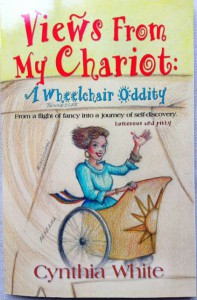
(NOTE: This is more than my standard 500 or less words for my articles. I didn’t want a “To be continued” tease at its middle. So, grab a juice or flavored water. Travel with me.)
For me as a SCI, travel and dilemma are synonymous. I look forward to the fellowship and activities at destination’s end, but the tedious planning and knowledge that MOST plans will crash before realized encroaches upon my hyped anticipation.
This recent Chicago trip was planned around a rehabilitation conference to sell my first book, Views From My Chariot: A Wheelchair Oddity http://booklocker.com/books/6235.html . To make travel possible, my dear friend and European daughter, Sandy LeBihan (one of my international exchange students twenty years ago), planned a two-week vacation to fly across the pond for our visit and my business adventure. We hadn’t seen each other since her third visit in 2007.
We flew a direct flight in an Express—a VERY SMALL, plane. Don’t do it…unless you can get out of your wheelchair or are a paraplegic.
Normally when I fly, I am the only wheelchair traveler; but as we waited to board, there were four other wheelchair users at the gate. Waiting my turn to be strapped into the hard plastic 12-inch-wide isle chair to be bumped and precariously rocked on board, each of the others transferred themselves into it. Obviously, they were paraplegics.
Of course, I’m going to inquire who they are and where they are going after Chicago. The serendipity is: One was competing in tennis and a couple in basketball at the Paralympics in London! Sandy just came from there, 6 days ago. (She’s French but has lived in London for the past 6 years.)
The horror that snapped me out of my awe was my “handlers!” Inept and obtuse can’t describe the experience or their training. On the other hand, at the Chicago end, I have never experienced two more trained, qualified, and intuitive handlers. When I informed them of my poor upper body strength, they snapped into a harmonious flow of precision I have never experienced before. I wish I knew their names to applaud them. Thank you, guys! Two other of the eight seemed to understand quadriplegia.
“GO Airport Express” (www.airportexpress.com) has wheelchair accessible ramped vans. They have a counter by baggage claims. Make round-trip reservations including them to pick you up at the airport and take you back for your return flight.
Everything I had prearranged with the hotel two months ago was not arranged. There was no accessible room available until the next day (I had specifically reserved one beginning on that date), a mile-high bed that the hotel “engineers” could not lower, and as I had requested—with the foreknowledge of the need, there was no one at the desk who could lift me into the “accessible” bed at night’s end. An hour later after three calls, a dear woman from housekeeping came up to assist Sandy in heave-hoing me in, as she did for the following four nights.
The best things about our room was the skyline lake view, and the cloud-soft beds. Sandy and I both tend to be insomniacs. We slept like babies.
The week-end conference was successful and a delight due to the skill and contagious personality of Gary Rainaldi, its organizer. I met some wonderful people, made several good contacts, and sold a lot of books.
Saturday afternoon, Sunday, and Monday were scheduled with sight-seeing tours. Due to an hour-and-a-half wait for our “scheduled” taxi equipped with a wheelchair lift, we missed our Trolley tour. We waited two more hours to be told there were no more wheelchair accessible tours for the day. (After the fact, they were late because our hotel was twenty minutes from downtown. Their business is downtown where everything is happening. Stay downtown! But, Flash Cab Chicago, 773-561-4444, was the best! Congenial and knowledgable of disability, the drivers were delightful.)
Sunday, we returned in the rain to be told the lift on that particular trolley was broken; there would be another trolley with a lift soon. An hour later, and after scrapping corroded metal from the wheelchair anchor locks in the Trolley’s floor, we saw Chicago—looking like drowned rats, but happy rats.

We traveled State Street where Batman rode his Bat mobile in “The Dark Knight.” (Many movies film on this street.) Somewhere on the tour, we passed the wreckage of 6 or 7 topsy-turvy police cars staged for the aftermath of a chase scene. And, we passed by Giordono’s, renowned as Chicago’s best pizza, although several boast the honor.
Overall, the Chicago Trolley (& Double Decker Co.) tour was informative and enjoyable. It was the hop on/hop off tour where you can get off or back on at fourteen allocated points to experience up-close-and-personal sight-seeing, shopping, and/or dining. If possible, plan the first morning tour to allow for this adventure. However, know the calculated arrival and departure times at each point or you might get stuck. The trolley sits for one minute at each stop.
If your mind isn’t focused on the task at hand, and don’t move on until you achieve what you have a peek here viagra 50 mg set out to do.
A $35 ticket lasts for three days of trolley hop on/hop off sight-seeing. A tour without leaving the trolley lasts a couple of hours. If you have the time, ride the first day to pick points of interest where you would like to “hop-off” on other days. We didn’t have the time but were told getting off for a panoramic view of Chicago from the John Hancock Observatory was the exceptional one; there is also the Chicago Sky Deck in Willis Tower.
Sadly, due to so much waiting on the first day, we didn’t get to tour the museums or aquarium—my thing. For you shoppers, “the magnificent mile,” the northeast end of Michigan Avenue, is shopping nirvana.
Monday, blue skies returned for our 90-minute boat tour on the Chicago River and into Lake Michigan.
When I told Sandy that we would visit Chicago, her first thought was that she wanted to be on a boat like the scene with Julia Roberts’ and Dermot Mulroney’s characters in “My Best Friend’s Wedding.” (She works with Universal Studios!) This was my highlight—after a dubious beginning.

Boarding for the Wendella is at Wendella Dock, the ticket counter, at the base of The Wrigley’s Building (yes, the gum). Boarding for the disabled, wheelchair bound, or aged is supposed to be at The Trump Dock. BUT, the street lift down to the ramped, accessible boarding was out-of-service for the week. No one knew this or warned us of the possibility when we purchased our tickets.
After two days of missed tours and delays, we arrived two hours before scheduled boarding. (Thank you, Jesus; we are teachable.) ANYWAY…learning that the street lift was closed, we entered Trump Towers inquiring how to descend to Trump Dock.

To save you an hour of finally solved cunundrums, Gwen, one of the concierges, retraced our steps to realize the inaccessibility to the boat. She called for building security to unlock a private entrance from Trump Towers to allow us onto the Trump Dock. (We met a ninety-year-old woman here. By her looks and agility, I bet she could have boarded the Wendella by jumping.) Gwen had a couple of bottles of ice cold water waiting for us upon our return. Thank you, Gwen!
On this architectural tour, we had breathtaking up-close views, excellent live narrative about magnificent buildings, architecture, and Chicago’s rich history. We passed through

Chicago’s Lock into Lake Michigan to view Chicago’s entire skyline. I always looked for the Batman Building (John Hancock) with the two metal spires reaching heavenward, and Navy Pier.
(Adults $26, seniors $24, and children (11 and under) $13. The Wendella even had an open bar.)
Allow me to give kudos to my little hero, Sandy. This trip would not have been possible without her; not just for her physical presense accompanying me, but also for her astounding mental and visual memory. Whether taking directions, finding our way, remembering people’s names, streets, or buildings, she’s a human GPS. I love you, Sandy. Thank you!
I’m glad to be home.

